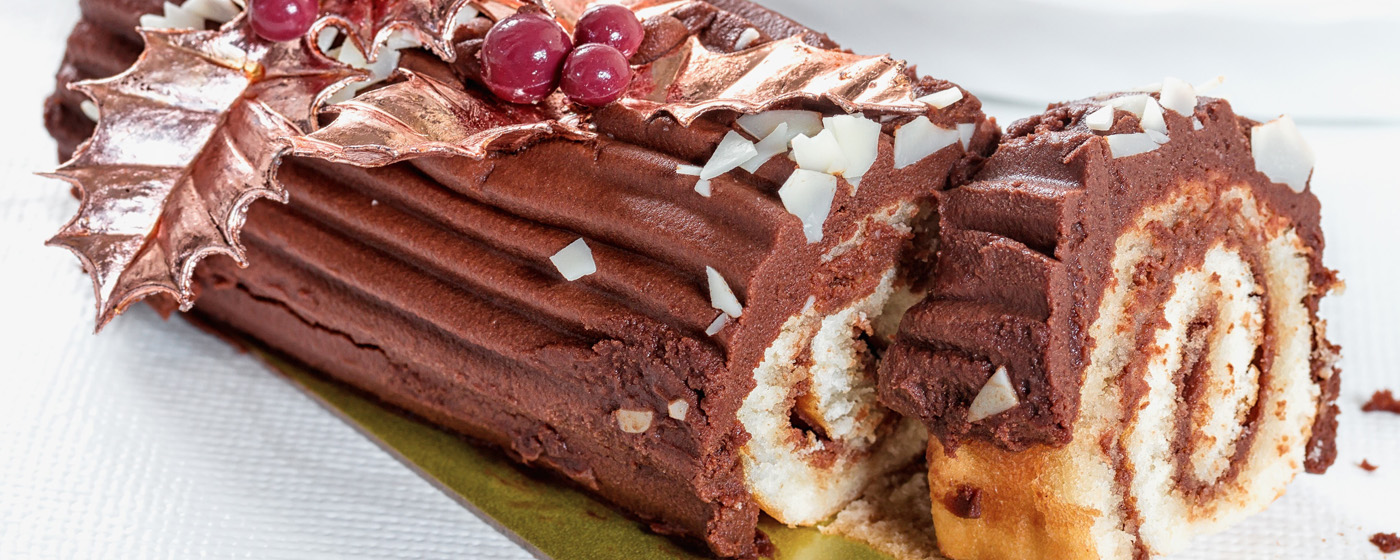Christmas food
For thousands of years, the winter solstice period has been celebrated as a transition from darkness to light. During Late Antiquity and the Early Middle Ages, Christian festivals gradually fell in line with pagan celebrations. The birth of Jesus was celebrated in multiple ways and ritualised through food. The Yule log and the biscuits and baubles that decorate Christmas trees today originate in highly symbolic secular traditions.
The winter solstice and the birth of Jesus
Winter has long been the season of festivals. The solstice on 21 December marks the end of long nights and the gradual return of daylight. Different pagan populations in Antiquity celebrated this transition from darkness towards light and abundance.
In Northern Europe, during the Yule festival, the return of the sun was welcomed by burning large logs. The feast lasted for as long as it took the wood to completely burn.
The Saturnalia festival was held in ancient Rome in honour of Saturn, who some considered to be, among other things, the god of agriculture. The usual social rules no longer applied: everyone gathered together, regardless of their rank, to join in the lavish celebrations. At this same period, some Romans from the wealthy classes celebrated the Juvenalia to mark the transition from childhood to adulthood. They also honoured Mithra, the Persian sun god and saviour, by commemorating him on 25 December. After the conversion of Constantine the Great to Christianity in the 4th century, Christian festivals gradually aligned with pagan festivals and people began to celebrate the birth of Jesus.
From the Christmas tree to the cake and biscuits on the Christmas tree
The partial assimilation of pagan traditions by Christian festivals not only facilitated the evangelisation of pagans at the beginning of Christianity, but also saw the emergence of a variety of ways of celebrating the birth of Jesus. This array of interpretations was expressed through different dishes.
In Europe, a specific cake was made especially for Christmas: the French bûche, the English Christmas pudding and the German Weihnachtskuchen. The tradition of the bûche, or Yule log, a symbol of prosperity, originated in Northern Europe. The Yule festival coincided with the winter solstice and lasted as long as it took for the log to burn. This tradition continued with Christianity. In Europe in the Middle Ages, a large piece of oak or pine tree was carried by the family’s children and placed in the hearth to create a fire which would burn as long as possible. This ritual was performed to bestow long-lasting blessings on the family. The tradition later died out when gas heating and radiators were introduced. To preserve the symbol, French pastry chefs created a dessert in the shape of a tree trunk decorated with festive symbols: the Yule log. Each region of France used to have its own traditional dessert, but now the log has become widespread.
In the Middle Ages, people also decorated Christmas trees with small wafers, resembling unconsecrated communion hosts called oblates (from late Ecclesiastical Latin oblata meaning ‘offering’) which thus evoked the Eucharist. Christmas trees were also adorned with red apples to symbolise the tree of paradise. The coloured baubles used today serve as a reminder of the apples of the past. As for the small decorative biscuits, they still adorn Christmas trees, especially in the Czech Republic.
Christmas banned
In the 17th century, the wave of religious puritanism which swept over Anglo-Saxon countries led to a ban on the celebration of Christmas, considered as a pagan festival. The British colonists of the New World refused to celebrate it. In Boston between 1659 and 1681, anyone showing any indication of taking part in such festivities was fined. It was only on 26 June 1870 that Christmas was officially declared a public holiday in the United States.
CATINOT-CROST, Laurence, 2015. Noël en France, Histoire et traditions. Tours : Éditions Alan Sutton.
CRÉTIN, Nadine, 2015. Fêtes de la table et traditions alimentaires. Toulouse : Éditions Le Pérégrinateur.
LOUGUINE, Sophie, 2007. L’album des fêtes de Noël et Nouvel An autour du monde, Histoires, Costumes, Recettes, Rites, Traditions, Paris : Éditions Pierre Horay.
NOËL, Marie-France et LE CORRE, Christian, 2008. Noël : Histoire et traditions. Rennes : Éditions Ouest-France.
POLI, Brigitte, 2002. Les 13 desserts provençaux. Une coutume en mouvement. Montfaucon : Librairie contemporaine.
CONRAD, Philippe, 2001. Origines et traditions de Noël. Nouvelle Revue d’Histoire Clio. Décembre 2001.




